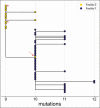Genomic Epidemiology and Transmission Dynamics of Severe Acute Respiratory Syndrome Coronavirus 2 (SARS-CoV-2) in Congregate Healthcare Facilities in Santa Clara County, California
- PMID: 34328176
- PMCID: PMC8385848
- DOI: 10.1093/cid/ciab553
Genomic Epidemiology and Transmission Dynamics of Severe Acute Respiratory Syndrome Coronavirus 2 (SARS-CoV-2) in Congregate Healthcare Facilities in Santa Clara County, California
Abstract
Background: Outbreaks of SARS-CoV-2 in long-term care facilities (LTCFs) cause significant morbidity and mortality. Mapping viral transmission within and between facilities by combining genomic sequencing with epidemiologic investigations enables targeting infection-control interventions.
Methods: We conducted weekly surveillance of residents and staff in LTCFs in Santa Clara County, California, with ≥1 confirmed COVID-19 case between March and July 2020. Positive samples were referred for whole-genome sequencing. Epidemiological investigations and phylogenetic analyses of the largest outbreaks (>30 cases) were carried out in 6 LTCFs (Facilities A through F).
Results: Among the 61 LTCFs in the county, 41 had ≥1 confirmed case during the study period, triggering weekly SARS-CoV-2 testing. The 6 largest outbreaks accounted for 60% of cases and 90% of deaths in LTCFs, although the bed capacity of these facilities represents only 11% of the LTCF beds in the county. Phylogenetic analysis of 196 whole-genome sequences recovered from those facilities showed that each outbreak was monophyletic, with staff and residents sharing a common viral lineage. Outbreak investigations revealed that infected staff members often worked at multiple facilities, and in 1 instance, a staff member infected while working in 1 facility was the likely index case in another.
Conclusions: We detected a pattern of rapid and sustained transmission after a single introduction of SARS-CoV-2 in 6 large LTCF outbreaks, with staff playing a key role in transmission within and between facilities. Infection control, testing, and occupational policies to reduce exposure and transmission risk for staff are essential components to keeping facility residents safe.
Keywords: elderly; epidemiology; genomics; healthcare; providers.
© The Author(s) 2021. Published by Oxford University Press for the Infectious Diseases Society of America. All rights reserved. For permissions, e-mail: journals.permissions@oup.com.
Figures



References
-
- US Census Bureau. QuickFacts: Santa Clara County, California. Available at: https://www.census.gov/quickfacts/santaclaracountycalifornia. Accessed 3 October 2020.
-
- County of Santa Clara. COVID-19 long-term care facility (LTCF) dashboard—novel coronavirus (COVID-19). Available at: https://www.sccgov.org/sites/covid19/Pages/dashboard-long-term-care-faci.... Accessed 16 February 2021.

